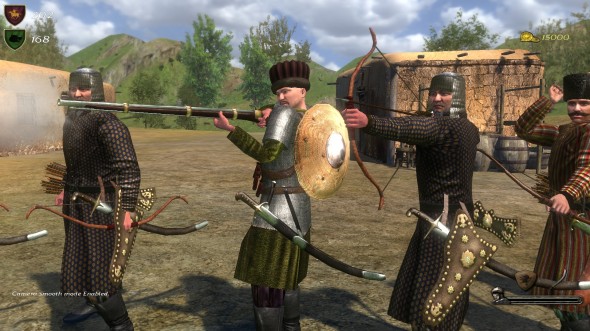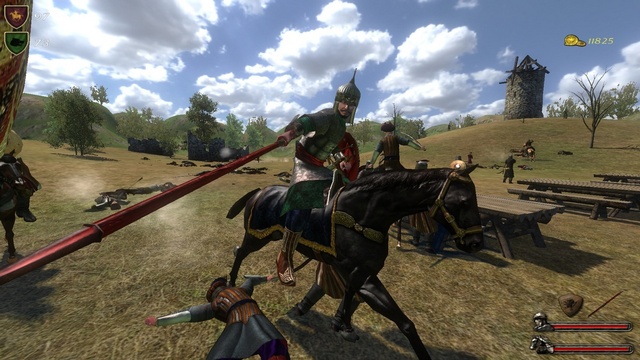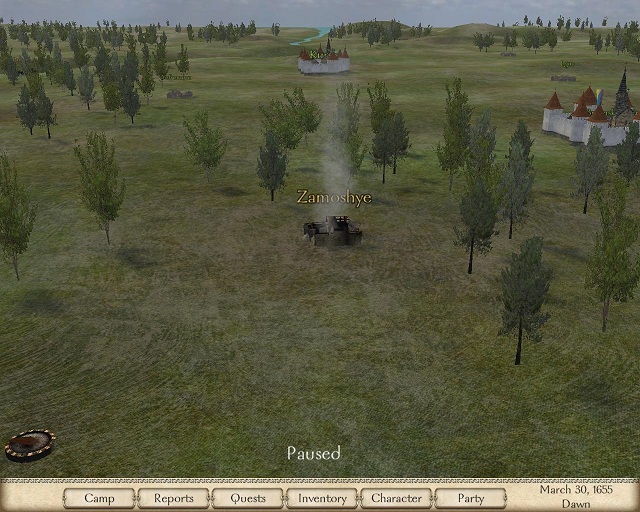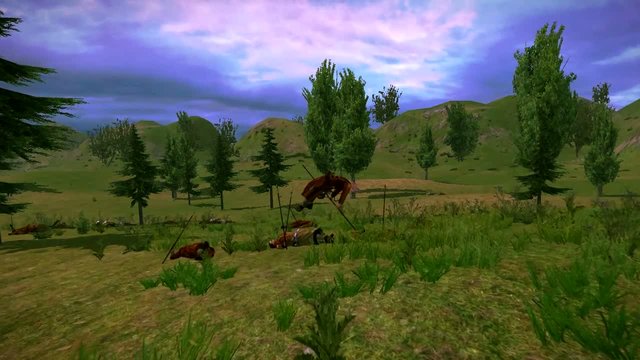I hadn’t had much experience with the Mount and Blade series before, but as I eased into Sich Studio and TaleWorlds’ With Fire and Sword, I discovered a game with great scope, but also deeply flawed with overly realistic and obtuse gameplay mechanics and low production values. Jumping into the skin of a nameless character in 17th century Eastern Europe, it is up to the player to develop himself in a variety of different fields and negotiate politics to achieve dominance. Unfortunately, lots of flaws drag down the experience to result in a very deep game with a focus on freedom, but also regrettable frustration.

At its base, With Fire
and Sword is a sandbox strategy game with heavy RPG elements. Taking
control of a newly generated character (male only), the player then has the
ability to put points into a variety of attributes, skills and weapon proficiencies that augment gameplay abilities; Horseback Riding improves accuracy and damage
on horseback, while Leadership allows for more units to be recruited into your
army. Once a name and statistics are chosen, the player designs the facial
features of the hero from a fair amount of preset faces, a huge amount of ‘staches
and full Oblivion-style plastic
surgery options. Unfortunately, the graphics of Mount and Blade are a little bit better than those of Morrowind or a similar
game from 2001; these graphics are compounded by the fact that the overworld
map is a flat featureless board, dotted with unimpressive rivers, singular
trees and a little bit of green to show that you're moving over grass. Of course, I have to give it credit that hundreds of soldiers can be on screen at any one time, so reductions in graphics may be required in this instance. Towns
are small sterile collections of boxes and citizens with short patrol paths,
while cities add walls to the mix. There is essentially no interaction with the
environment other than interacting with NPCs, but this is mostly to gather
information about the world at large (sometimes reasons to sack a town are
revealed).
The primary user interface is through the world map screen,
which allows you to observe movements of armies as they move from city to city,
as well as bandits or deserters that are more interested in your money and
equipment. Locations are bookmarked and easily referenced for travel,
thankfully. The sun rises and falls as days pass, with movement speed altered
by poor visibility at night. Upon arriving in a town, the player is given a
menu of options that range from consulting the king, mayor or elder of a town
for quests, favors or miscellaneous needs, to visiting the marketplace
(sometimes split into separate sections, depending on the size of the
settlement) to looting or razing the town proper. One sign of the limited resources devoted to this game is the lack of voice acting, instead it relies on masses of text for each conversation. However, you do have an awful lot of
things to do in each town, and this was one of the bright spots in the game
that is sorely lacking in other open-world titles. Taverns provide information and
possible recruits into your army as well as providing special characters to
help ransom prisoners that have been captured by your enemies. Eventually, as
you become famous and your army becomes large and powerful, you can join a
faction and become liege of a section of territory, be it granted or captured. Unfortunately,
this is where the game struggles.
As a strategic RPG-RTS hybrid, the combat interface begins when you choose to battle an enemy army rather than choosing to pay them off to leave you alone. At the beginning of the game, you are alone and must wage war in either a 3rd-person view or 1st person view, both clunky to say the least. A close comparison would be Dynasty Warriors. But beware, as playing this game like that one will quickly get you killed. The smallest enemy army is at least 7 members, and each enemy has about the same chance of killing you as you do them. Melee is very difficult to utilize, as any attack you make requires at least a second to execute after clicking the button, and any damage you take in that time will interrupt the process (horseback slashing is unreliable at best). This means that at most you can fight one other fighter in melee fairly, as enemies tend to stack on each other and hit you simultaneously. With staggered hits coming in from all sides, you essentially have no chance to get out an attack of your own unless you run away; you can block attacks, but only one at a time, and your blocking has to be precise as well in order to prevent them from attacking somewhere else on your body.

The only way I feel I was able to reliably defeat enemies
was (at first) to circle strafe groups, letting off shots every 5 seconds from
my horribly inaccurate flintlock pistol (you basically have to run targets down
to get a reliable shot, even at higher levels of proficiency), but even then
your chances of success are random as most enemies have a ranged weapon in
reserve, usually a gun, which has the ability to One-Hit-Kill you. If you’re by
yourself, you are usually able to avoid foot infantry (as you start off
mounted) but survival becomes a random affair when enemy ranged attacks may get lucky
and actually hit you. If you are "killed", you are captured, made prisoner for a
few days, relieved of some money and items, and released. Sometimes I was
captured by the same army immediately after they released me, leading to a
situation where I had no weapons, armor, horse (each of which cost a huge
amount) or money; this catastrophe set me back to less than what I had at the
beginning, leading me to start over. There is no in-game save feature: to
prevent quicksaving and quickloading to avoid issues like this, the function
was stripped out entirely, only allowing saves upon exit.
The low chance of survival by yourself eventually teaches you that the only way to fight numbers reliably is to bring your own numbers to the table. Usually at forts or cities a tavern exists where you can recruit soldiers to your cause; the type of soldier is usually random, but can range from standard infantry, to pikemen, to archers, to musketmen, to mounted cavalry, mounted archers and mounted musketmen. For a more substantial supply, mercenary camps dot warzones that you pass through, and you have the option of visiting one to purchase specific numbers of troops from each category. These troops follow you into battle to be sectioned off and allow for unit tactics (archers firing from a hill, mounted cavalry breaking a line) or can be sacrificed to act as rearguard so the greater army can escape. This is where the core of the combat comes through, and your allies are not always brain-dead.

In addition to the singleplayer campaign, there is a large multiplayer component that comes in the form of several game modes, wherein each a limited amount of cash is provided to outfit your character before the beginning of the round or upon respawn. The particular amount of cash that is granted is dependent on personal and team performance, depending on the mode. With Fire and Sword brings all the game modes from Warband, including Deathmatch, Team Deathmatch, a round-based Battle, Siege, Fight and Destroy, Conquest and Capture the Flag; each mode has the capability to support up to 250 soldiers at a time, making for fairly intense battles.
Deathmatch is a free for all, with players choosing a variety of weapons, armors and mounts to fight with a short respawn. Team Deathmatch introduces teams into the mix, whereas Battle eliminates short respawns in favor of rounds (with one team left standing). Siege allows one team to man the turrets of a castle, where another attempts to capture it using ladders, siege engines, and the like. Fight and Destroy is an attack and defend scenario in which an object must be protected against a hostile force, Capture the Flag allows players to capture and return a flag from enemy territory, and Conquest is a king of the hill style game in which capture points are defended from other teams.
The new addition for With Fire and Sword is the inclusion of the Captain Team Deathmatch, where players outfit themselves but also are able to choose and command a squad of AI soldiers consisting of 4 to 24 men, depending on the quality of troop. This allows teams to coordinate on a more controlled scale and maintain the feel of the singleplayer game as a strategy game, rather than a single soldier running around targeting anyone they can find.
Each mode has a different focus, but the essential gameplay remains the same in which a player can choose equipment and a playstyle (depending on the mode) which usually boils down to infantry, ranged infantry and cavalry, although the equipment allows for significant custom cross-class play. The multiplayer is just as deep as the singleplayer game, and provides a depth of play to suit any one style. It quickly becomes apparent that players who have learned the skillful system of blocking and attacking will run rings around newer players; With Fire and Sword provides nothing but options.

Mount and Blade: With
Fire and Sword is a game with tremendous depth, but stymied with low
production values and difficult gameplay mechanics in some areas. It could be
great if more care were applied to streamline this issues, but despite this
and the game’s high difficulty, it would give a hardcore gamer a good time. I
wouldn’t hope to get very far if you weren’t completely dedicated to success or had a lot of time to burn to learn the intracacies that are inherent in this title. Developed
by Sich Studio and TaleWorlds, M&B:
WFaS was published by Paradox Interactive on May 3rd, 2011 for
PC.